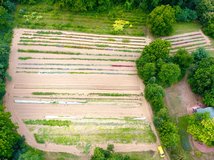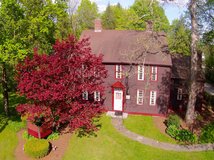What, no Frisbees?
UPDATED Friday morning with Cinda response to Anons
Now that the first eminent domain article failed on the floor of Amherst Town Meeting, mainly due to Finance Committee advice, socialistic NIMBY zealots are getting a tad nervous with the other -- even more controversial -- eminent domain article, coming up for discussion Monday night. Also unanimously opposed by our fiscal watchdogs, the Finance Committee.
Amazingly they are trying to back away from the heavy handed use of eminent domain. Since most red blooded Americans believe passionately in property rights (even in Amherst), they probably should have thought of that before placing the article on the warrant.
Note opening sentence
 Gerry Weiss
Can we have a sane discussion about right of first refusal? I could be
wrong, but I believe that when land is taken out of 61, the Town has the
right of First Refusal. It's the law and it's not personal. And if my
memory serves me, it's not even Town Meeting that decides on whether to
buy the land, it's the Select Board in consultation with various
committees and the Town Manager. So, no one can take this land against
your will via the right of first refusal. As far as Town Meeting goes,
again, they can't take your land. They can give authorization to the
Town to commit a certain amount of money toward a purchase. That's what
Town Meeting does as far as land deals goes - it is the money
authorizer; the Town (Musante and the SB) has the final say on making an
offer or taking by eminent domain a property. I'll bet a lot of money
that the Town of Amherst will not take your land by eminent domain.
Gerry Weiss
Can we have a sane discussion about right of first refusal? I could be
wrong, but I believe that when land is taken out of 61, the Town has the
right of First Refusal. It's the law and it's not personal. And if my
memory serves me, it's not even Town Meeting that decides on whether to
buy the land, it's the Select Board in consultation with various
committees and the Town Manager. So, no one can take this land against
your will via the right of first refusal. As far as Town Meeting goes,
again, they can't take your land. They can give authorization to the
Town to commit a certain amount of money toward a purchase. That's what
Town Meeting does as far as land deals goes - it is the money
authorizer; the Town (Musante and the SB) has the final say on making an
offer or taking by eminent domain a property. I'll bet a lot of money
that the Town of Amherst will not take your land by eminent domain.
o 
Cinda Jones There are two questions on the table, Gerry Weiss:
1) Does 2/3 of Town Meeting support Article 43?; and
2)
Does the Select Board, after receiving community input and advice from
the Conservation Commission and the Planning Board, want to advantage
its Right of First Refusal (ROFR) under Mass. General Laws, Chapter 61?
These are two completely different questions.
(You
say this is "not personal," but Save Cushman supporters have made this
very personal by making groundless complaints to the Department of
Environmental Protection and Amherst Conservation Commission on our
logging jobs approved by the MA Department of Conservation; engaging in
daily public harassment of our young forester; making anonymous public
personal attacks on me; and committing vandalism at my brother's retail
store.)
The Save Cushman group's Warrant Article 43 http://www.amherstma.gov/DocumentCenter/View/22485)
asks if the Town will vote "to acquire from WD Cowls, Inc., or their
successors by Eminent Domain, purchase, gift, or otherwise in fee simple
as a conservation restriction, easement, or other interest therein..."
Regardless
of what Warrant Article 43's supporters now claim they meant, Article
43 expressly authorizes the town of Amherst to take land by eminent
domain against the will of the owner. If its advocates do not want that
legal authority, then the eminent domain language should be stricken
from Article 43.
Unlike in Article 43, under ROFR the town has the
option of, within 120 days, taking over a Purchase and Sale Agreement.
The purchase and sale contract being considered by the town today as a
bona fide offer has an immediate $50K deposit due and a purchase price
of $6.5 million, with a closing within 2 years. This contract is for
purchase of the land. It’s not for a CR.
Under the ROFR the town
can't do what the Warrant Article 43 asks unless it uses Eminent Domain.
If the town uses its ROFR to buy the property under the contract terms,
it can't say, "we want to buy a CR" (a CR is not for sale) or "we want
to fund raise for a while and then buy 70% to conserve and 30% when we
get that money and then on 30% we will develop something the community
wants but not student housing."
In conclusion, Gerry, to answer your
questions, yes the town can authorize the expenditure of $1.2 million,
but the only way Save Cushman can do what they want is through a hostile
Eminent Domain taking of Cowls' land. I'm not a willing seller and I
will not under any circumstances sell a Conservation Restriction when I
have a contract to sell the entire property for $6.5 million, providing
much needed student housing in a cluster development that permanently
preserves a large portion of the property.

Response from Cinda to Anons 5/30 4:47 & 3:59
Here
are some facts that should help answer your questions a paraphrase as:
Would we be seeing the Retreat proposal (for a student-occupied
residential subdivision in the woods) at this time if we had we passed
some of the several recent Village Center zoning change proposals that
would have allowed more units in existing already-built areas?
According to the just-released Amherst Residential Market Demand Assessment Amherst’s household growth has lagged behind other Pioneer Valley towns
with less than 1% growth between 2000 and 2010 but during this same
time period the town’s population increased nearly 3,000 people – all
college students. The report states that “the lack of new residential
development (particularly to support the increase in student population)
has led to” several serious problems including neighborhood home to
rental conversions and serious affordability issues.
- In the 50 years between 1960 and 2010 Amherst’s population grew 176% and our housing only increased 125%.
- 59% of people living in Amherst are college students.
- Student
competition for scarce rental units is driving up costs and making
Amherst unaffordable for families, seniors, and town employees.
- More than half of our housing units – 54% - are renter-occupied.
Way more than half of these - 3,300 of 5,400 units - are occupied by students.
- Amherst’s
Master Plan was quoted in the Housing Production Plan, identifying as a
key objective: “supporting the creation of taxable student housing that
will lessen the pressures on residential neighborhoods.” The Master
Plan directs the location of such housing to existing village centers,
on town water and sewer.
People have said “UMass students should be living on UMass land.”
Well…
UMass tried to gift the town the Gateway corridor for private
development of student housing on what’s now UMass property. But we said no.
Folks have said “Cushman is the wrong place.”
But
we said no to JPI building 400 units on the Hadley side of Route 116
and then “No” to the Hope Church building on land near the University
and existing multi-unit rentals.
We
said “No” three times to re-zoning proposals that encouraged infill at
the town’s existing village centers of Atkins Corner and North Amherst.
Amherst
is at least 10% below its housing needs. Our recent and future growth
have to go somewhere. Where do we want it? If we don’t decide, the
market and existing conditions will.
Antidotally,
I can tell you that over the past 12 years I’ve had at least a dozen
student housing developers approach me looking for appropriate sites for
well-managed student housing developments. Their models were all
apartment style or high rises. There is no place in Amherst that’s not
already built where we allow this.
In
October 2012 I received my first call from Landmark. I was just
getting out of my mouth “yes I know there’s huge demand and need for
this housing, but there’s no place available that’s zoned appropriately
in Amherst and zoning change requests prove impossible lately” - when
Jason said Landmark’s model is a gated residential subdivision of
cottages – that he was looking for land zoned for residential homes. I
thought “Holy cow. Somebody finally figured out how to do it.” And the
deal was made pretty quickly.
My
answer to your question is “Yes.” Had the Village Center rezoning
passed, or had we zoned some place in town appropriate for more units,
and specifically some places appropriate for student housing, there
would be a lot less demand for residential subdivisions in the woods.
Demographics
are changing. Seniors (the likely fastest growing population after
students) want to live in Amherst’s Village Centers where they can walk
or bus to restaurants or shops. Young folks starting out in the work
force enjoy a more in-town experience too. We can’t change the fact
that more than half of all renters in Amherst are students, but allowing
more units of housing in Village Centers will generate a healthy mix of
seniors and professionals as well.
Until
Amherst stops saying “NO” to every Town Meeting zoning change proposal
that would allow more units in sensible locations, there will be
development people question in locations where it’s allowed.
Cinda











































